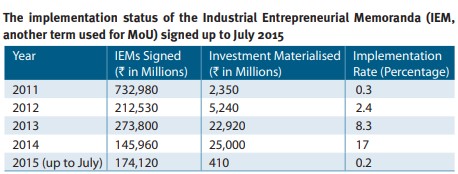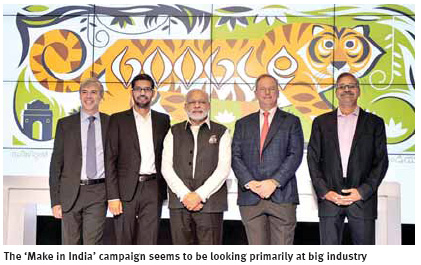FOLLOWING the global recession, the Indian economy is possibly heading towards a tail-spin. Responding to this crisis, Prime Minister Narendra Modi invited top industrialists and businessmen to discuss ways and means to revive the economy. Their panacea was the Goods and Services Tax (GST), easy land acquisition, reduction in interest rates and labour reforms. Viewed practically, these suggestions cannot stand objective scrutiny. Implementing GST would equalise the tax rates on goods consumed by the rich and the poor. The burden of tax on the poor will rise, resulting in corresponding decrease in their demand, thereby worsening the ongoing recession. Implementing the ‘not-yet-amended’ Land Acquisition Act could severely impact India’s food security. As consumption in India is not driven by credit cards, reducing interest rates will not revive demand. Drastic labour reforms in an employment-starved country could cause industrial unrest.
Last year, while launching the ‘Make in India’ campaign in Delhi, about 10 of these very big industrialists and businessmen were put on the dais and they pledged to invest billions of rupees. Some weeks ago, the same scenario was repeated while kick-starting the ‘Digital India’ initiative and billions were again promised. It is as if only these super-rich gentlemen will ‘develop’ this country as a super-power economy!
To be fair to the present ruling dispensation, this obsession commenced with the Narasimha Rao-Manmohan Singh jugalbandi during the ‘reform era’ of the early-1990s, when the Domestic Direct Investment (DDI)-driven ‘economic idea of India’, as propounded by the Founding Fathers of the Republic, was abandoned and replaced with the Foreign Direct Investment (FDI)-based industrial development model. The sui generis philosophy of ‘small-is-beautiful’ gave place to the western concept of ‘big-is-bountiful’. It was the latter philosophy that drove the Gujarat model of development.
One of the ways to propitiate this model was to eject the small enterprises from the economic scene and give a free run to the big players. This was admirably done by the Yashwant Sinha (Union Finance Minister in the BJP-led NDA I)-piloted draconian Securitisation and Reconstruction of Financial Assets and Enforcement of Security Interest Act, 2002 (SARFAESI Act), that empowered banks/financial institutions to shut down and seize all assets of industries/enterprises, declaring them as Non-Performing (NPA)! Though applicable to all industries, it was rarely used for FDI and big ticket projects. But small/medium DDI-based enterprises were sealed and sold off even for a small delay in repaying loan instalments.
UPA I and II pursued the FDI model with full passion with the then Finance Minister, Palaniappan Chidambaram, chanting the FDI-GDP mantra almost every day. Prime Minister Manmohan Singh, being the patron of this model, was in full gear. Since this predatory model of development did not fulfil the aspirations of the Indian people—providing employment and ensuring inclusive and equitable growth—the UPA was ruthlessly defeated in the 2014 parliamentary election.
The BJP-majority NDA II took over the reins with Modi in charge. He did not do any due diligence to ascertain the efficacy of the big-ticket FDI model to achieve the two things—inclusive development and rapid employment generation—which he and his party promised if voted to power. Instead, from day one he clung to his Gujarat model, which people did not understand during his campaign, and has been globetrotting to solicit FDI in big ticket projects from rich countries.
The Economic Times (September 21, 2015) reports that because of these visits, India has ‘received’ $19.78 billion (Rs. 1.30 lakh crore) in FDI in 2014-15. ET also reports that among the countries that Modi visited, Japan has committed to invest about $35 billion in five years and South Korea about $10 billion. China has assured $20 billion in the next five years, while France has announced $2 billion Euros ($2.26 billion). The UAE, which the PM visited last month, has promised to pump in money for India’s $75-billion infrastructure fund. The UK has launched a programme for investments here, ahead of Modi’s planned trip in November, and Germany is expected to make some announcements related to the ‘Make in India’ initiative during Chancellor Angela Merkel’s visit to New Delhi in the first week of October. His second visit to the US, especially to Silicon Valley, the capital of the ‘Digital World’ could fetch promises of billions, if not trillions more!
STATE chief ministers have been following suit with many of them travelling to foreign shores with big entourages, conducting conferences and ‘road shows’ to ‘attract’ billions from big-ticket investors. Prominent among these states are Andhra Pradesh, Telangana, Maharashtra and Haryana. But J Jayalalithaa of Tamil Nadu out-did them all by lining up many big-wigs at Chennai itself, extracting MoUs to invest Rs.2,42,160 crore ($36.88 billion) by God alone knows when and on what!

In all this typical bureaucratic fund and figure discourse, there is no whisper as to the adverse impact of these gargantuan foreign investments on India’s landscape, environment and domestic resources and the trade-off in terms of employment generation, wealth creation and poverty elimination, if any. Furthermore, this kind of ‘FDI hunt’ at the present juncture defies logic because under recessionary conditions there is little possibility of large amounts of foreign investments actually coming in despite promises made and the MoUs signed. This is proved by the data put out by the Directorate of Industrial Policy and Promotion (DIPP) for the last four years (see table). As could be seen, the overall implementation rate is 5.64 per cent. If not for 2014, possibly due to big-ticket power projects like those of the Adani Group, the figure could have been much lower. There could be various reasons for this dismal performance. The private investor could have lost funding for the proposed projects. The MNCs’ appetite for expansion/diversification would have slackened because the demand for Indian-made goods slumped in foreign markets due to recession. Under such conditions, most MNCs don’t have enough profit margins to generate surplus. It is irrelevant whether India has low or high fiscal deficit.
Yet, the Confederation of Indian Industry, proponents of MNCs and big-ticket investments, is elated as could be seen from the statement of its mentor, Tarun Das: “Foreign firms had switched off India in the last couple of years (of the previous government), but they have been upbeat in the past year… Modi has been able to integrate foreign policy with economic and corporate policies…A big change has been brought in the approach towards foreign investors by the PM deciding to meet individual CEOs of global business giants. When domestic investments are constrained and Indian banks have huge NPAs, FDI is key to boosting economy.” Indeed so, if you do not care about inclusive growth and diversified employment generation.

All those in pursuit of MNCs, FDIs and huge sums of foreign money fail to answer one question which is of paramount importance for India having highest ‘demographic dividend’ in the world—what is the unemployment rate for different skill levels and how much and what kind of employment will these massive ‘investments’ generate in the country? The fact is that, in addition to the huge backlog, India adds a million people with varied skills to its workforce every month and there is an urgent need to create jobs for them. This calls for reliable and timely information and evidence on jobs in a big way to help decision-making. But, there is a gaping hole here and the statistical system falls between three stools—the National Sample Survey Office (NSSO), Central Statistics Office, and the Labour Bureau, Ministry of Labour and Employment—leading to variations in estimates and actual. Even after six decades of planning, the policymakers have no idea as to the scale of unemployment and the kind of jobs that need to be generated to cater to the ever growing workforce with diverse education/skill levels!
THIS apparition is staring at our face in Uttar Pradesh, the most populous state in India. When the UP government advertised for posts of 368 peons on August 11, more than 2.3 million applications poured in—roughly 6,000 per post. Among the applicants are more than 200,000 graduates and post-graduates (including technology and engineering graduates) and also 255 people with PhDs. The minimum qualification for the post was Class V pass, but only 53,000 of the applicants had not studied beyond Class V. Can any of the above agencies predict such an avalanche though, according to an NSSO report released in 2013, around 13.2 million people in UP in the 15-35 age group are unemployed?
State-wise analysis of demographics suggests that the government’s pursuit of MNC-driven investment, ejecting small and medium enterprises, will be tested in the crucible of job generation in states like UP, Bihar, Madhya Pradesh and Rajasthan, which will account for more than 50 per cent of the increase in the working-age population between 2011 and 2021. These four states—the poorest in terms of per capita income—will add nearly 54 million to India’s workforce, while the four affluent states—Maharashtra, Gujarat, Punjab and Haryana—will add only 22 million. The ‘big-is-bountiful’ development model, hoping for trickle-down benefits, is bound to fail this test.
It is, therefore, imperative that a proper assessment of the job market and the kind of investment needed to create as many jobs as possible be done immediately. A proper strategy should then be chalked out. Triggering domestic demand by increasing the incomes of people, thereby enhancing their purchasing power, should be the chosen strategy. The best way to do this is to actively promote DDI-driven small and medium enterprises, which can create more jobs for different skill categories all over the country.

FOR this, the government should take certain steps, such as disincentives for industries/factories using automatic machines, reducing taxes on small factories with a large labour force and subjecting all FDI proposals to stringent employment audit to make sure that the number of jobs created by fresh investment is more than the number of jobs that get eaten away. Other measures could be to repeal the SARFAESI Act for small enterprises; providing reliable and quality power through decentralised and distributed generation; simplifying labour laws for small industries; and improving infrastructure in small towns where these industries would be concentrated. Giving remunerative prices to farm products could put more money in the hands of farmers and increase their purchasing capacity. It is also imperative to rework the rules of the WTO to provide protection to DDI-funded labour-intensive industries across the country.
Among the towering leaders after Independence, Jayaprakash Narayan (JP) was the strongest votary of this DDI-based model of industrial/economic development that could spread the fruits of growth and prosperity and give the aam aadmi a place in the sun. Way back in the early 1970s, he had invited EF Schumacher, the author of the famous book Small is Beautiful, to present this concept to Prime Minister Indira Gandhi. Nothing much came of it. JP’s death and birth anniversaries fall in the month of October and Modi considers him his icon. If this is true, Modi should listen to the sane voice of JP and do a full review of the ‘development’ model he is pursuing, which could, at best, bring acche din to 300 million people, leaving the remaining near-1,000 million lagging behind.
India’s land area, resources and carrying capacity are limited, compared to its huge population which ranges from the super-rich to the stinking-poor. In such a milieu, the DDI-centred ‘small-is-beautiful’ is the right side to drive. The FDI-based ‘big-is-bountiful’ is driving on the wrong side!
The writer is a former Army and IAS officer. Email: deva1940@gmail.com

























































